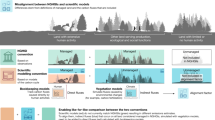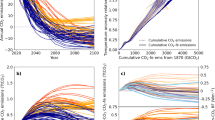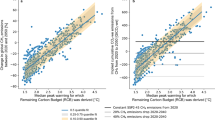Abstract
Some of the differences between recent estimates of the remaining budget of carbon dioxide (CO2) emissions consistent with limiting warming to 1.5 °C arise from different estimates of the level of warming to date relative to pre-industrial conditions, but not all. Here we show that, for simple geometrical reasons, the combination of both the level and rate of human-induced warming provides a remarkably accurate prediction of remaining emission budgets to peak warming across a broad range of scenarios, if budgets are expressed in terms of CO2-forcing-equivalent emissions. These in turn predict CO2 emissions budgets if (but only if) the fractional contribution of non-CO2 drivers to warming remains approximately unchanged, as it does in some ambitious mitigation scenarios, indicating a best-estimate remaining budget for 1.5 °C of about 22 years’ current emissions from mid-2017, with a ‘likely’ (1 standard error) range of 13–32 years. This provides a simple, transparent and model-independent metric of progress towards an ambitious temperature stabilization goal that could be used to inform the Paris Agreement stocktake process. It is less applicable to less ambitious goals. Alternative definitions of current warming and scenarios for non-CO2 drivers give lower 1.5 °C budgets. Lower budgets based on the MAGICC simple modelling system widely used in integrated assessment studies reflect its relatively high simulated current warming rates.
This is a preview of subscription content, access via your institution
Access options
Access Nature and 54 other Nature Portfolio journals
Get Nature+, our best-value online-access subscription
$29.99 / 30 days
cancel any time
Subscribe to this journal
Receive 12 print issues and online access
$259.00 per year
only $21.58 per issue
Buy this article
- Purchase on Springer Link
- Instant access to full article PDF
Prices may be subject to local taxes which are calculated during checkout



Similar content being viewed by others
References
Millar, R. J. et al. Emission budgets and pathways consistent with limiting warming to 1.5 °C. Nat. Geosci. 10, 741–747 (2017).
Goodwin, P. et al. Pathways to 1.5 °C and 2 °C warming based on observational and geological constraints. Nat. Geosci. 11, 102–107 (2018).
Tokarska, K. B. & Gillett, N. P. Cumulative carbon emissions budgets consistent with 1.5 °C global warming. Nat. Clim. Change 8, 296–299 (2018).
Mengis, N., Partanen, A.-I., Jalbert, J. & Matthews, H. D. 1.5 °C carbon budget dependent on carbon cycle uncertainty and future non-CO2 forcing. Sci. Rep. 8, 5831 (2018).
Schurer, A. P., Mann, M. E., Hawkins, E., Hegerl, G. C. & Tett, S. F. B. Importance of the pre-Industrial baseline for likelihood of exceeding Paris goals. Nat. Clim. Change 7, 563–567 (2017).
Schurer, A. P. et al. Interpretations of the Paris climate target. Nat. Geosci. 11, 220–221 (2018).
Mauritsen, T. & Pincus, R. Committed warming inferred from observations. Nat. Clim. Change 7, 652–655 (2017).
Rogelj, J., Schleussner, C.-F. & Hare, W. Getting it right matters: Temperature Goal Interpretations in Geoscience Research. Geophys. Res. Lett. 44, 10662–10665 (2017).
Rogelj, J. et al. Paris Agreement climate proposals need a boost to keep warming well below 2 °C. Nature 534, 631–639 (2016).
Hienola, A. et al. The impact of aerosol emissions on the 1.5 °C pathways. Environ. Res. Lett. 13, 044011 (2018).
Meinshausen, M., Raper, S. C. B. & Wigley, T. M. L. Emulating coupled atmosphere–ocean and carbon cycle models with a simpler model, MAGICC6 – Part 1: Model description and calibration. Atmos. Chem. Phys. 11, 1417–1456 (2011).
IPCC Climate Change 2014: Synthesis Report (eds Core Writing Team, Pachauri, R. K. & Meyer L. A.) (IPCC, 2015).
Peters, G. P. Beyond carbon budgets. Nat. Geosci. 11, 378–380 (2018).
Rogelj, J. et al. Differences between carbon budget estimates unraveled. Nat. Clim. Change 6, 245–252 (2016).
Haustein, K. et al. A real-time global warming index. Sci. Rep. 7, 15417 (2017).
Allen, M. R. & Stocker, T. M. Impact of delay in reducing carbon dioxide emissions. Nat. Clim. Change 4, 23–26 (2014).
Otto, F. E., Frame, D. J., Otto, A. & Allen, M. R. Embracing uncertainty in climate change policy. Nat. Clim. Change 5, 917–920 (2015).
Matthews, H. D. et al. Estimating carbon budgets for ambitious climate targets. Curr. Clim. Change Rep. 3, 69–77 (2017).
Millar, R. J. & Friedlingstein, P. The utility of the historical record for assessing the transient climate response to cumulative emissions. Phil. Trans. R. Soc. Lond. A 376, 20160449 (2018).
Van Vuuren, D. P. et al. Alternative pathways to the 1.5 °C target reduce the need for negative emission technologies. Nat. Clim. Change 8, 391–397 (2018).
Shindell, D. et al. Simultaneously mitigating near-term climate change and improving human health and food security. Science 335, 183–189 (2012).
Wigley, T. M. L. The Kyoto Protocol: CO2, CH4 and climate implications. Geophys. Res. Lett. 25, 2285–2288 (1998).
Manning, M. & Reisinger, A. Broader perspectives for comparing different greenhouse gases. Phil. Trans. R. Soc. Lond. A 369, 1891–1905 (2011).
Report on the Structured Expert Dialogue of the 2013–2015 Review FCCC/SB/2015/INF.1, paragraph 39 (UNFCCC, 2015).
Bindhoff, N. L. et al. in Climate Change 2013: The Physical Science Basis (eds Stocker, T. F. et al.) Ch. 10 (IPCC, Cambridge Univ. Press, Cambridge, 2013).
Millar, R. J. et al. Reply to ‘Interpretations of the Paris climate target’. Nat. Geosci. 11, 222 (2018).
Rhode, R. et al. A new estimate of the average Earth surface land temperature spanning 1753–2011. Geoinfor. Geostat. https://doi.org/10.4172/2327-4581.1000101 (2013).
Allen, M. R. et al. Warming caused by cumulative carbon emissions towards the trillionth tonne. Nature 458, 1163–1166 (2009).
Matthews, H. D., Gillett, N. P., Stott, P. A. & Zickfeld, K. The proportionality of global warming to cumulative carbon emissions. Nature 459, 829–832 (2009).
Ricke, K. L. & Caldeira, K. Maximum warming occurs about one decade after a carbon dioxide emission. Environ. Res. Lett. 9, 124002 (2014).
Zickfeld, K. et al. Setting cumulative emissions targets to reduce the risk of dangerous climate change. Proc. Natl Acad. Sci. USA 106, 16129–16134 (2009).
Jenkins, S. et al. Framing climate goals in terms of cumulative CO2-forcing-equivalent emissions. Geophys. Res. Lett. 45, 2795–2804 (2018).
Allen, M. R. et al. A solution to the misrepresentations of CO2-equivalent emissions of short-lived climate pollutants under ambitious mitigation. npj Climate Atmos. Sci. (in the press).
MacDougall, A. H., Zickfeld, K., Knutti, R. & Matthews, H. D. Sensitivity of carbon budgets to permafrost carbon feedbacks and non-CO2 forcings. Environ. Res. Lett. 10, 125003 (2015).
Millar, R. J., Nicholls, Z., Friedlingstein, P. & Allen, M. R. A modified impulse-response representation of the global near-surface air temperature and atmospheric concentration response to carbon dioxide emissions. Atmos. Chem. Phys. 17, 7213–7228 (2017).
Clarke, L. et al. in Climate Change 2014: Mitigation of Climate Change (eds Edenhofer, O. et al.) Ch. 6 (IPCC, Cambridge Univ. Press, Cambridge, 2014).
Kirtman, B. et al. in Climate Change 2013: The Physical Science Basis (eds Stocker, T. F. et al.) Ch. 11 (IPCC, Cambridge Univ. Press, Cambridge, 2013).
Morice, C. P., Kennedy, J. J., Rayner, N. A. & Jones, P. D. Quantifying uncertainties in global and regional temperature change using an ensemble of observational estimates: The HadCRUT4 data set. J. Geophys. Res. Atmos. 117, D08101 (2012).
Foster, G. & Rahmstorf, S. Global temperature evolution 1979–2010. Environ. Res. Lett. 6, 044022 (2011).
McGuire, A. D. et al. Dependence of the evolution of carbon dynamics in the northern permafrost region on the trajectory of climate change. Proc. Natl Acad. Sci. USA 115, 3882–3887 (2018).
Ehlert, D. & Zickfeld, K. What determines the warming commitment after cessation of CO2 emissions? Environ. Res. Lett. 12, 015002 (2017).
Myhre, G. et al. in Climate Change 2013: The Physical Science Basis (eds Stocker, T. F. et al.) Ch. 8 (IPCC, Cambridge Univ. Press, Cambridge, 2013).
Le Queré, C. et al. Global carbon budget 2016. Earth Syst. Sci. Data 8, 605–649 (2016).
Hoesly, R. M. et al. Historical (1750–2014) anthropogenic emissions of reactive gases and aerosols from the Community Emissions Data System (CEDS). Geosci. Model Dev. 11, 369–408 (2018).
Acknowledgements
We would like to thank P. Forster for proving up-to-date forcing series for our analysis, and J. Rogelj for his helpful comments and advice on this study. N.J.L., S.J. and E.G. were supported by the NERC DTP, MOAP and ECI student placement schemes; R.J.M. and M.R.A. are supported by the Oxford Martin School and ECI; and K.H. is supported by the World Weather Attribution Project. We acknowledge the WCRP’s Working Group on Coupled Modelling and thank the climate modelling groups for producing and making available their model output.
Author information
Authors and Affiliations
Contributions
N.J.L., R.J.M. and M.R.A. conceived the study; N.J.L. produced all figures except Supplementary Fig. 4; K.H. provided updated estimates of human-induced warming and performed the analysis generating Supplementary Fig. 4; S.J. contributed code for the calculation of CO2-fe emissions and E.G. helped with the analysis and checking of the IIASA MAGICC simulations. N.J.L. and M.R.A. wrote the paper, with all authors contributing.
Corresponding author
Ethics declarations
Competing interests
The authors declare no competing interests.
Additional information
Publisher’s note: Springer Nature remains neutral with regard to jurisdictional claims in published maps and institutional affiliations.
Supplementary information
Supplementary Information
Supplementary Methods and Figures
Rights and permissions
About this article
Cite this article
Leach, N.J., Millar, R.J., Haustein, K. et al. Current level and rate of warming determine emissions budgets under ambitious mitigation. Nature Geosci 11, 574–579 (2018). https://doi.org/10.1038/s41561-018-0156-y
Received:
Accepted:
Published:
Issue Date:
DOI: https://doi.org/10.1038/s41561-018-0156-y
This article is cited by
-
The meaning of net zero and how to get it right
Nature Climate Change (2022)
-
Integrating attribution with adaptation for unprecedented future heatwaves
Climatic Change (2022)
-
Quantifying non-CO2 contributions to remaining carbon budgets
npj Climate and Atmospheric Science (2021)
-
Non-CO2 forcing changes will likely decrease the remaining carbon budget for 1.5 °C
npj Climate and Atmospheric Science (2020)
-
Delayed emergence of a global temperature response after emission mitigation
Nature Communications (2020)



